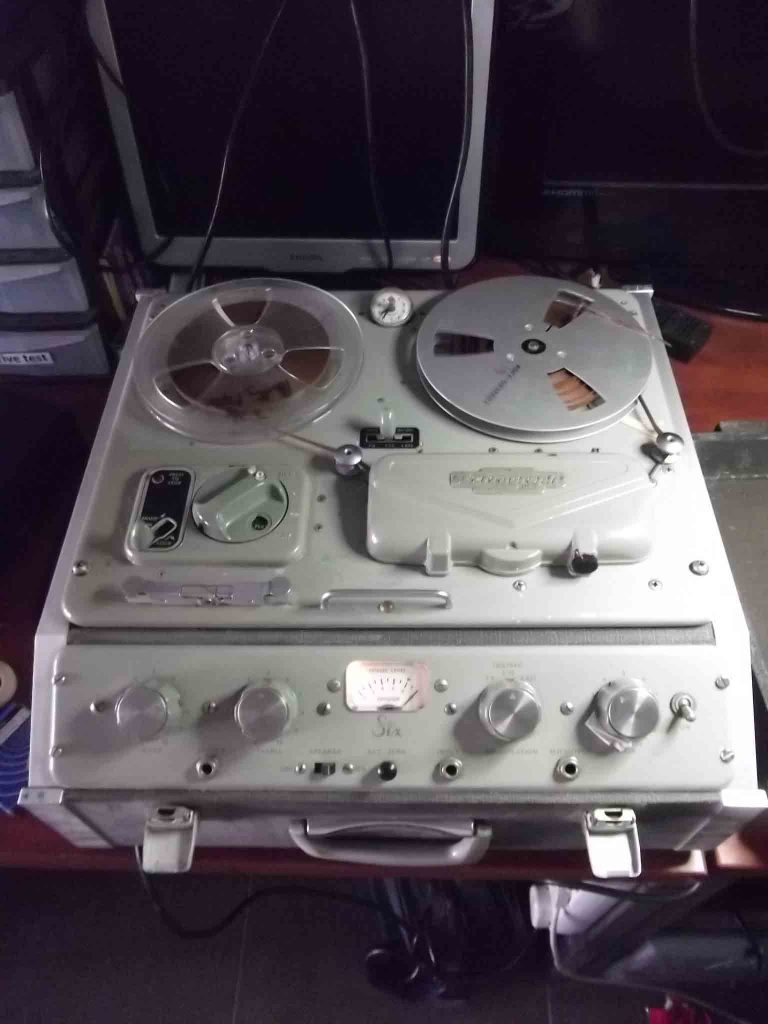In part 1, I wrote about the beginnings of sound recording, centered around discs. This month we will look at how tape recording developed.
Recording onto discs was expensive and the equipment cumbersome. In the late 1800s, an American developed a machine named the Poulsen Telegraphone. This used reels of thin steel magnetic wire. Using motors running at a set speed, the wire passed at some velocity, across the surface of a recording head. The head, basically an electromagnet, was supplied with an amplified signal, say from a microphone. This signal modulated the magnetic structure (domains) of the wire. When the wire was wound back and replayed across the head, the magnetic imprint of the wire caused a signal to appear at the output of the head. This small signal, when amplified, gave you a sort of authentic reproduction! Amongst other drawbacks, the steel wire rusted and was heavy.
In the ‘20s, a German chap, Kurt Stille, came up with a variation on the wire recorder, this time using a very thin metal tape. Tape was 6mm wide and about 0.08mm thick. He called it a Blattenerphone. Great name. These machines were not to be messed with. The reels of steel tape weighed a ton and the speed that the tape passed the recording heads was around 5 foot a second! When the tape broke, it was like being sprayed with razor blades, decapitating anyone in a 100 mile radius. There was an improvement in sound over the wire system. The BBC bought a few it but realised it was a stop gap.
In the ‘40s, two companies, Ampex and 3M, in the U.S. set about taking tape recording to the next stage. A paper tape magnetically doped was designed. This was a big improvement over the steel tape. At the end of WW2, an engineer, John Mullin was sent to Germany to look at the advancements in recording made there. He came back with some AEG equipment, tapes and set about improving the systems. Bing Crosby who was a massive recording star also helped out as anything that would promote domestic reproduction (sound that is) would be huge business for record companies and so on. In ’47 Bing Crosby recorded several shows and the tapes allowed broadcasting all over the U.S. He put his hand in his pocket and invested $50,000 in the Ampex Company. This started tape recording as we now know it.
The standard of ¼ inch wide tape was adopted. This was now made from thin plastic polymer, with a magnetic oxide coat on one side. In the ‘50s, professional recording machines such as the BRT2 developed by EMI, were running the tape at speeds of 15 or 30 inches a second, passed the recording and replay heads. The tape could be cut and edited and the quality was great. The Beatles at Abbey road studios recorded early material on these machines. Other manufacturers such as Philips, Leevers-Rich and Swiss made Studer made superb machines.
In the ‘50s, home recording took off. Tape recorders were coming down in price and you could afford a 5” reel of tape. The standard domestic machine ran at a tape speed of 3 ¾ inches a second. It gave you about 20 minutes a side of tape. The tape was a ¼ inch wide and the area of the recording head was a little under 1/8 of an inch. The head being placed at the edge of the tape, meant when you finished recording on one direction (track on the top of the tape), you could turn the reels of tape over and record on the lower track in the other direct. This doubled your recording time. BSR as well as making record players made great budget tape machines. The more expensive semi-professional machines had higher tape speeds which increased the quality of recordings. Stereo was also available and some machines had a 3rd replay head. This was fitted alongside the recording head, so you could listen to what was being recorded in real time, in order to check levels etc. The played back sound was delayed by a fraction of a second, the time it took for the tape to pass from recording head to play head. It gave you an echo effect! This facility was used throughout the recording industry. The famous WEM CopyCat Echo machine used a loop of tape and several replay heads to give a range of effects. Any self respecting Rock n Roll band had one!
Next month….Cassettes! Bet you can’t wait.
Seth Pittham




